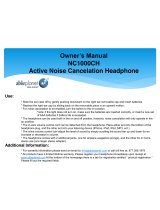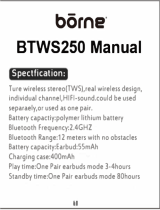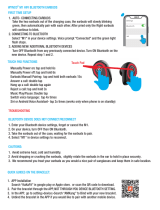
IMPORTANT SAFETY INSTRUCTIONS
2
|
ENG
Please read and keep all safety and use instructions.
Important Safety Instructions
WARNINGS/CAUTIONS
• Do NOT use the headphones with noise canceling mode at any time the inability to hear surrounding sounds may
present a danger to yourself or others, e.g., while riding a bicycle or walking in or near trac, a construction site or
railroad, etc.
• Keep batteries out of reach of children.
• Please dispose of used batteries properly, following any local regulations.
• Danger of explosion if batteries are incorrectly replaced.
• Batteries may cause a fire or chemical burn if mishandled. Do not recharge, disassemble, heat, or incinerate.
• When a replacement is needed, use only a AA (LR06) alkaline batteries.
Please read and save this guide
Please read this guide carefully. Save this guide for future reference and make it easily accessible for passengers and
third parties who use this headset.
• Switch to an alternate communications method in the event of a headset issue.
In the unlikely event of any headset issue or failure in the passive noise reducing mode, switch to an alternate
communications method and use standard cockpit resource management skills to minimize distractions.
• Use the headset at a moderate volume level.
To avoid hearing damage, use the headset at a comfortable, moderate volume level. Limit the headset volume to
safe levels that do not interfere with your ability to hear informational sounds and warning alarms, such as stall
warnings or gear up, while piloting.
• Turn the headset o if it emits any loud noise.
As with any complex electronic device, it is possible for this headset to fail during operation. Symptoms of failure,
which may include loud tones, distortion, feedback squeals and loss of communications signal in the headset, can
occur in either the Acoustic Noise Cancelling™ mode (turned on) or in the passive mode (turned o). If the headset
emits any loud noise and the related loss of communications in the Acoustic Noise Cancelling™ mode, turn o the
power switch. The headset will continue to provide communications in the passive noise-reducing mode. If the
problem persists, see “Troubleshooting” on page 44.
• Be aware of sound dierences while wearing the headset.
With the headset’s active and passive noise reduction, typical aircraft sounds (such as engines, propellers, warning
alarms, and other sound sources) may not sound familiar. Make sure you can hear and recognize these sounds when
using the headset while operating any aircraft.
• Do NOT make phone calls while piloting.
Do not use the headset for telephone calls during flight operations.
• Make sure your aircraft communications system volume control is easily accessible.
This control aects the strength of the communications signal coming into the headset. Make sure you can
understand critical communications even with Acoustic Noise Canceling mode turned o. In this case, you may need
to turn up the aircraft communications system volume. In passive mode, the volume controls on the control module
will automatically be set to maximum volume. For additional volume control, use the intercom or radio volume
control. If your headset is aircraft powered, connect the headset to the aircraft power sources only as described in
“Aircraft Connectors” on page 28”.






















